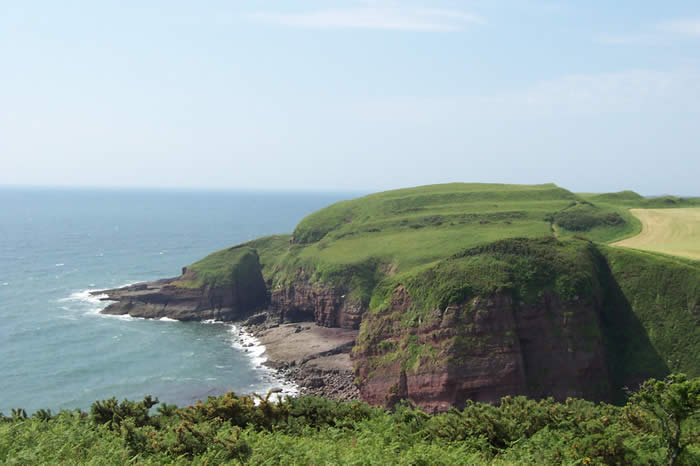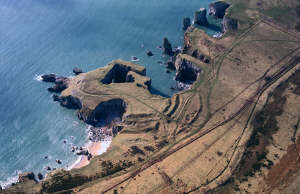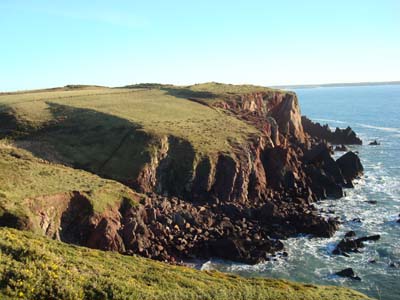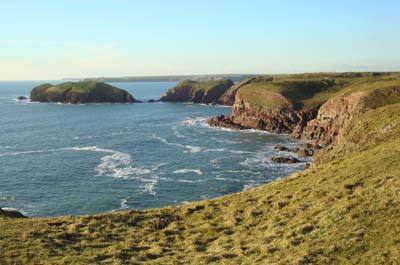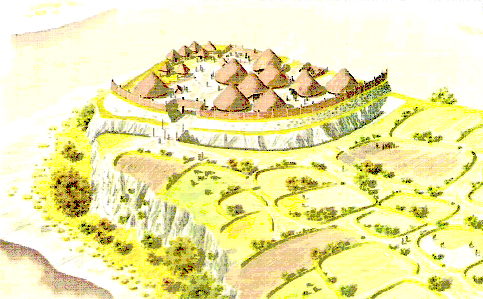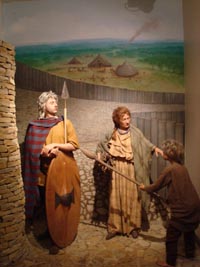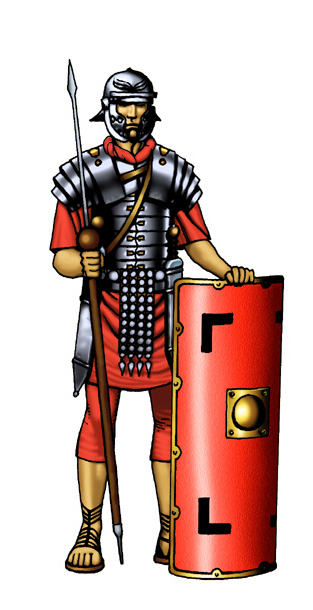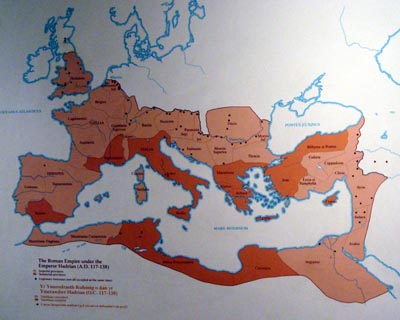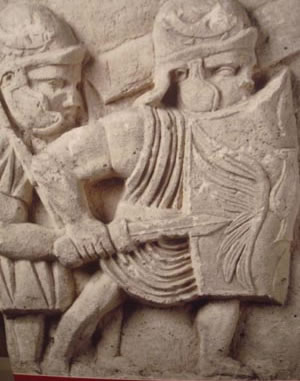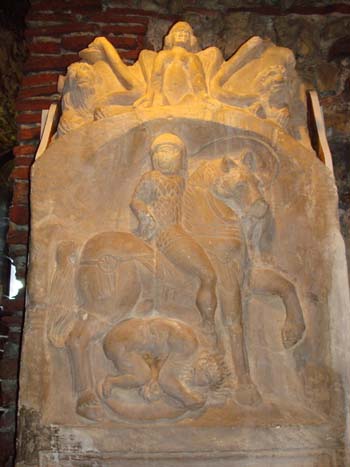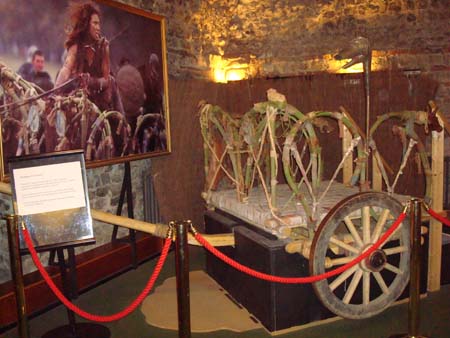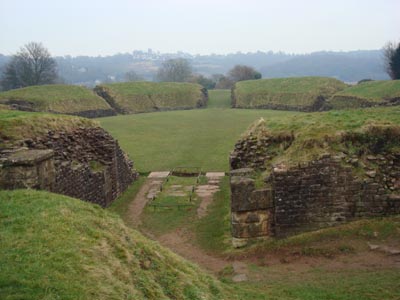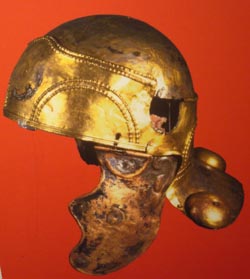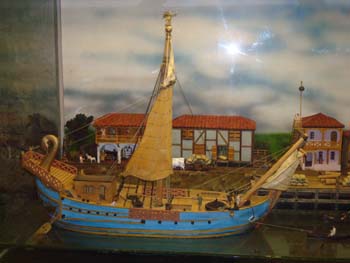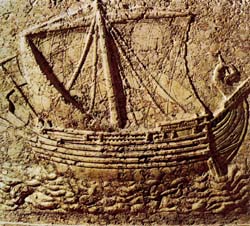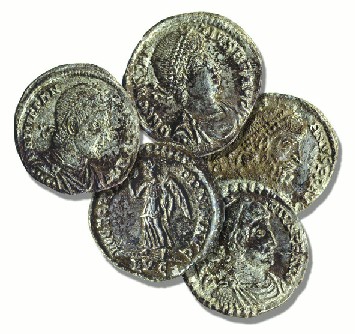
| HOME | ABOUT | PEMBROKE | MONKTON | HISTORY | LANDSCAPE | GALLERIES | PUBLICATIONS | CONTACTS |
Pembroke story history
IRON AND ROME
A Tribal Society By the end of the first century BC, the population of Britain evolved into a number of distinctive tribal groups speaking a common language. At the time of the Roman conquest of Britain in 42AD, Wales as a geographical expression did not exist: the tribes in Wales shared the same laws and customs as those in southern England. Then, we would have been Britons belonging to the Demetae tribe This period we call the Iron Age, so called because of the development of iron working, dates from around 750 BC to the Roman conquest of Britain in 43AD. During this time tribal leaders emerged who consolidated their territories by building defended settlements on hilltops and cliff promontories. Many of the hill forts built during the Iron Age still exist, their defensive ditches and earthen walls strikingly visible in the modern landscape. A series of concentric ditches was usually dg, encircling a hill top, or cutting across the approach the coastal headland, Sometimes these ditches were hacked out of solid stone, whilst the rubble from them formed the foundations of a series of walls, each one topped with a wooden palisade. Beyond the outermost ditch, additional protection might be provided by a setting of closely packed upright stones or timbers making it difficult for an enemy to rush the fort. Entrance into the settlement itself was through an elaborate series of strongly defended gateways. The interior of the fort was filled with a number of circular, thatched dwellings known as roundhouses, in which the leader and his followers lived.
The remainder of the tribe might well have lived outside the defences, retreating into the fort only in times of danger, Their homes, sited on the most productive agricultural land, were small defended farms consisting of an outer enclosure where cattle could he kept and a smaller area where the roundhouses were built. Most of the smaller settlements haven’t survived into modern times, as centuries of ploughing and cattle-grazing have eroded them away. The larger hill forts, because of their siting on marginal land, still exist. There are good examples at Greenala Point, on the coast between Freshwater East and Stackpole Quay, at Bosherton and at Flimston and Linney Head in the Castlemartin Ranges. There may have been a hill fort where Pembroke Castle now stands, but all trace of it has vanished under later building.
. Farming in the Iron Age During the Iron Age, the landscape was more intensively cultivated than you might think. In the more productive areas, field systems had been established during the Bronze Age, where beans, corn, barley, oats, rye and flax were grown, Fruits , nuts and berries were harvested in the autumn and cattle, sheep and goats grazed in the fields as well as providing meat, dairy products, leather and wool. Even the woodlands were carefully managed, producing timber for house-building, fences, walkways across marshy land and basic furniture.
Trade for some time before the Roman Conquest, there were very active trading links, both in Britain and with the continent. Luxury goods including eg wine were imported and many items including corn, metals and hides were exported. Most trade took place on a barter or exchange basis but towards the end of the Iron Age, there is evidence of currency bars and even the minting of coins. Art Iron Age people displayed a great love of decoration and ornament - swords, shields, torcs etc were beautifully worked with their distinctive artistic style based on geometric circles. Its timeless appeal makes it popular today. This was a sophisticated society. Visit Castell Henllys - a reconstructed Iron Age Fort The Pembrokeshire Coast National Park own and manage Castell Henllys, an inland hillfort near Newport. The roundhouses within the enclosure have been accurately reconstructed on their original foundations, and the whole site is given over to interpreting life in the Iron Age. Regular events at the site re-enact aspects of life in Iron Age Britain and Castell Henllys has won several awards for heritage education
Julius Caesar invaded Britain in 45 BC. Nearly 100 years later the Roman legions came to conquer. Resistance was led by Caradoc or Caractacus whose chief city was Colchester. The Romans, superior in arms and military discipline soon overcame all opposition in the east of Britain. In South Wales lived the Silures and beyond the Towy were the Demetae who would have inhabited this area. They gave their name to the later kingdom of Dyfed. Their capital was Carmarthen. Advancing westwards, the Romans crossed the Severn and placed a legion at Caerleon, in the land of the Silures. Caradoc travelled Britain encouraging resistance from South Wales to Northern England where it is said he was betrayed. Taken to Rome and led in chains through the streets to celebrate the Roman triumph.
The Romans turned to North Wales where they established a stong camp at Chester. Suetonius Paulinus in AD64 led his troops to the isle of Mon (Anglesey) where they destroyed the sacred groves and slaughtered the Druids, ending this ancient cult forever.
Meanwhile Boudicca led the tribes in the east to revolt and gave North Wales a brief respite. But agter her defeat they returned to conquer. Soon after the arrival of Agricola the most famous of the Roman generals in Britain in AD78, the whole of Wales became part of the great Roman Empire, which stretched from the Irish Sea to almost the Persian Gulf.
Boudica's chariot as seen in Colchester Museum. This was a reconstruction based on an Iron Age design for the ITV film starring Alex Kingston.
The Romans exercised a ruthless control of the countryside from a series of strategically placed fortresses such as Chester and York and , in Wales, at Caerleon. The occupation lasted for over 300 years. Authority was maintained by a system of forts connected by roads. South Wales was under the command of the Second Legion situated at Caerleon (ie Fort of the Legion) connected with a road to a further fort at Carmarthen.
Peace followed. Wherever the Romans conquered it was their policy to try and make the natives wear Roman dress, speak the Roman language and adopt Roman customs. In Wales Latin did not come into general use – here the Romans were little more than a military garrison, who kept order and exacted tribute, but allowed the natives to live much as they always had. There were major Roman towns at Caerwent and Carmarthen, where the amphitheatre still partially exists. Villas were built at, amongst other places, Ely, Llantwit Major and in the Vale of Glamorgan. No villas have yet been found in Pembrokeshire. There is a long-standing rumour of a possible marching camp at Whitesands Bay, though no traces of it have even been found. If one did exist, it was probably occupied only occasionally, when a routine patrol passed though the area. The Demetae, the local tribe living in Pembrokeshire, seem to have accepted Roman domination without too much trouble. Tribal settlements in south-west Wales continued to be occupied, though in some cases the populations moved out of the hillforts to live close by, even building new defences, These settlements were often smaller than the original forts and may have been occupied by few families. Roman pottery of the second and third centuries has been discovered in many sites, indication of a trade in Roman goods. In 1857 a hoard of Roman coins was discovered near Canaston Bridge, but no-one knows why this was buried for safety during a crisis, or as an offering to the gods? Roman coins have also been discovered at Pennar and within Pembroke castle itself.
The Roman naval fleet is know to have patrolled the Bristol Channel and and it is possible that they used Milford Haven as a base. End of Empire There is evidence of raids from Ireland during the late second/third centuries.The walls of the fort at Chester were rebuilt and on Anglesy and at Cardiff new forts were constructed. Towards the end of the 4th century the great Roman Empire was breaking up. Barbarians from N Germany were threatening. In 383 Maximus “Maxen Wledig” made himself emperor in Britain and Gaul and led the Roman army from Britain to the continent to capture Rome. He was slain. In 406 Constantine took another army over to Gaul leaving Britain defenceless. Increasingly under attack from Anglo-Saxons on the East and South coasts, Picts and Scots on the North and West, Britons now had to rely on themselves for the defence of their own country. In AD410 Rome itself was taken by the barbarians.
|
Through the Ages
 |
| Beginnings |
 |
| Iron and Rome |
 |
| Dark Ages |
 |
| Normans |
 |
| Earldom of Pembroke |
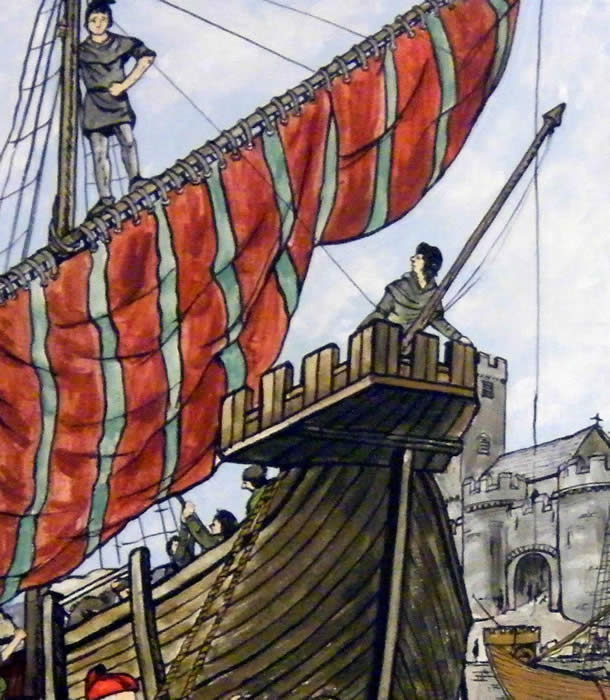 |
| Medieval Pembroke |
 |
| Wars of the Roses |
 |
| Tudor |
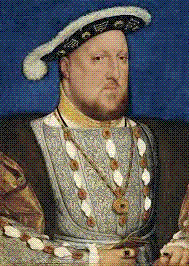 |
| Religious and political change |
 |
| Stuart & Civil War |
 |
| 18th Century |
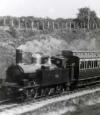 |
| 19th Century |
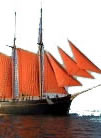 |
| Modern Times |
